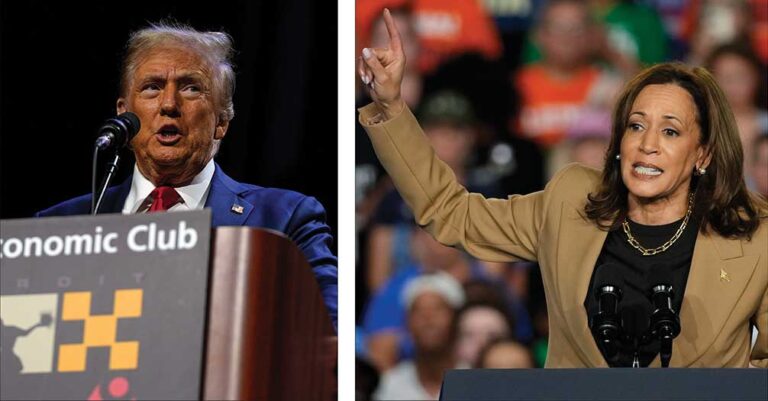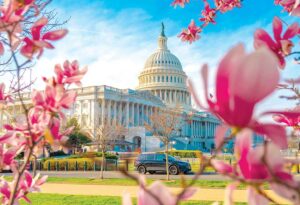Back in the 1800s, the term “silly season” was used to describe times when the newspapers, for a lack of any major events, focused on trivial or frivolous matters. Eventually, the phrase was applied to any time “marked by frivolous, outlandish or illogical activity or behavior,” according to Merriam-Webster.
This year’s election campaigns might be viewed by some pundits as outlandish, although truthfully, there’s nothing humorous when thinking about the future of the nation. Regardless, there’s no denying that campaigns have been marked by never-before-seen activities and occurrences.
The campaign season has been marked by historic events, including the last-minute resignation from reelection by an incumbent president and assassination attempts on a former president and current candidate. That’s not to mention the possibility of the first woman — and one of Black and Indian descent, at that — to occupy the Oval Office.
Through all those history-making events, the trucking business remains focused on issues critical to the industry, such as emissions regulations, truck parking, nuclear verdicts and drug testing, just to name a handful.
According to most, including Richard Sullivan, partner with the lobbying firm of State Federal Strategies, the issues that are top of mind for trucking are compliance with emissions laws and how to keep drivers safe while parking.
According to mandates issued by the Environmental Protection Agency (EPA), by 2032, 40% of all heavy-duty trucks on the roads must be zero emissions.
Sullivan said he believes a Harris administration will not only keep those standards but might make them even more stringent, which could influence corporate trucking entities to favor a Donald Trump presidency.
As the emissions battle continues, engine manufacturers are working to provide alternatives to the much-touted — and much maligned — battery electric option. While several motor carriers have adopted battery electric Class 8 vehicles for specialized use, such as drayage or local routes, the cost of converting the nation’s entire fleet is staggering.
But wait — the internal combustion engine (ICE) may yet prove to be a solution. Engine manufacturers and fuel experts have made great strides in developing ICEs fueled by renewable natural gas.
The issue of finding safe, affordable parking for big rigs continues to plague the industry even as consumers continue to buy goods that must be transported across the country.
“We live in an Amazon society,” Sullivan noted. “If you go to any apartment complex in Washington D.C., you will see many packages in the pickup lobby. How do you think those packages got there?”
The answer, of course, is “by truck.” As the number of trucks on the nation’s highways increases, so does the need for parking.
In late June, Congressional leaders announced that $200 million of the House Transportation Appropriations Subcommittee funding bill will be earmarked for truck parking. On July 12, the bill, HR 9028, was placed on the House calendar.
This bill directs the U.S. Department of Transportation (USDOT) to provide competitive grants for projects that provide public parking for commercial motor vehicles and improve the safety of commercial motor vehicle drivers.
States, metropolitan planning organizations, tribal governments and local governments are all eligible for these grants, which “must be used for projects on federal-aid highways or a facility with reasonable access to such a highway or a freight facility,” according to the bill.
In providing grants, the USDOT must determine the following criteria:
- That there is a shortage of commercial motor vehicle parking capacity in the corridor in which the project is located.
- That the eligible entity has consulted with motor carriers, commercial motor vehicle drivers, public safety officials, and private providers of commercial motor vehicle parking regarding the project.
- That the project will likely increase the availability or utilization of commercial motor vehicle parking, facilitate the efficient movement of freight or improve highway safety, traffic congestion, and air quality.
- That the eligible entity has demonstrated the ability to provide for the maintenance and operation of the facility.
According to a USDOT study, 98% of truck drivers say they regularly experience problems locating safe parking. An analysis by the American Transportation Research Institute revealed that the average driver sacrifices 56 minutes of drive time per day in search of a parking space — resulting in $7,105 in lost wages for drivers each year.
This new investment in truck parking would build on the progress that has been made through the Bipartisan Infrastructure Law that, which has already allocated funding to build roughly 2,000 truck parking spaces.
In addition to providing $200 million for truck parking, the House funding bill addresses a number of other trucking industry priorities, such as strengthening the Safe Driver Apprenticeship Pilot Program and blocking a waiver requested by California that would create a patchwork of meal and rest break rules, something many believe would undermine safety and the supply chain.
The bill would also prevent the Federal Highway Administration from moving forward with its proposal to impose greenhouse gas emissions performance measures on state departments of transportation and metropolitan planning organizations.
Additionally, the bill would prohibit the implementation of any congestion truck-only tolling programs, such as the one planned by New York City that has now been indefinitely suspended.
How will the next presidential administration impact trucking? Time will tell — but for the most part, the trucking industry remains bipartisan, focusing on the issues that truly matter.
Bruce Guthrie is an award-winning journalist who has lived in three states including Arkansas, Missouri and Georgia. During his nearly 20-year career, Bruce has served as managing editor and sports editor for numerous publications. He and his wife, Dana, who is also a journalist, are based in Carrollton, Georgia.









I hear the DOT is putting up billions for more truck parking. the problem is that grant money is going to just a very few “friends” of the government party. They can spend 4.2 BILLION and increase truck parking in a few spots by 250 parking slots.
Leave it to this government. They know how to throw away money.